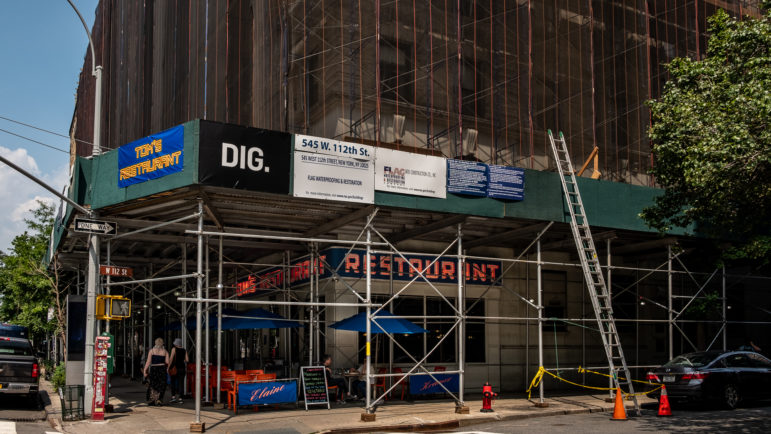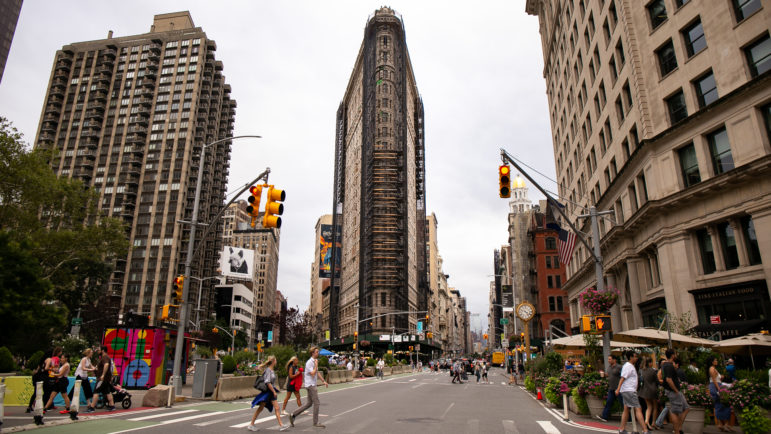
Adi Talwar
A view of scaffolding-clad Tom’s Restaurant at Broadway at 112th Street, used for the fictional Monk’s Café in the television sitcom Seinfeld.Sorry, Seinfeld sightseers. You won’t be able to snap a photo of a certain iconic Morningside Heights diner for a while.
Tom’s Restaurant on Broadway, the real-life setting of Seinfeld’s Monk’s Cafe, has been concealed by steel and plywood since spring so that the building owner, Columbia University, can complete renovations. That might be a blow to the local economy, but at least one Seinfeld tour guide is cool with it.
“If it saves one life it’s worth it,” says Kenny Kramer, the real-life inspiration for his namesake character.
That’s the point of the (theoretically) temporary structures—even if it annoys neighbors, spoils a staycation destination or Instagram shot.
There were 9,172 active sidewalk sheds across the five boroughs on Friday, according to the Department of Buildings (DOB)—about a third constructed after city officials identified issues during mandatory five-year inspections. The rest are intended to protect pedestrians during building renovations proactively pursued by owners.
Read More: Bid to Change City’s Scaffolding Law Stirs Old Debate
The first iteration of the regulation, known as Local Law 11, was enacted in 1979 after a piece of stone that broke free off the face of an apartment building struck and killed a 17-year-old Barnard College student. Four decades later, the regulations continue to drive an industry trading in tons of wood, piping and green paint.
Under the law, also known as the Facade Inspection Safety Program, property owners of buildings six stories and up are required to undergo regular inspections and maintain buildings in a “safe” condition, leading to a proliferation of scaffolding across the boroughs. There are now over 342 miles of sidewalk shed in New York City, predominately in Manhattan, according to a project tracker on the DOB website. That’s roughly enough material to build a covered bike lane between the Bronx and Buffalo, and then onward to Niagara Falls.
And with so many sheds in place, there are bound to be some New York City landmarks hidden underneath, like the familiar sign outside Jerry, George and Elaine’s favorite place to kvetch over coffee—or grab a big salad.
“We’ve done lots of them on iconic sites,” said Arsenal Scaffold owner Phil Susi. “We did New York City Center, we were at 240 Centre Street. Lots of buildings on Madison Avenue, 5th Avenue.”
Susi counts the Waldorf Astoria as his most memorable job. The Arsenal website features several photos of the hotel draped in protective fabric as well as a long sidewalk shed adorned with an elegant hotel sign. Another company has since erected scaffolding there as the luxurious lodgings undergo additional renovations.
Last year, Susi’s company purchased about 1,000 gallons of green paint to coat the wood in accordance with city sidewalk shed rules, he said. The industry has proven to be recession-proof, despite a temporary work stoppage in April 2020, he said.
The strict safety requirements and the ever-changing face of New York City mean temporary sidewalk sheds are a permanent feature of the cityscape.

Adi Talwar
A view of the Flatiron building with scaffolding from 5th Avenue at 24th Street.
The Flatiron Building has been encased since 2019—“Currently covered in scaffolding. Not worth seeing at the mo,” reads the bookmarked review on TripAdvisor. Wall Street’s Federal Hall National Memorial will soon suffer the same fate, disappearing behind protective layers until as late as 2030. There’s a shed outside the Chelsea Hotel and even some scaffolding along the High Line.
At least one landmark is now free from its construction cocoon: The tubes and netting recently came off the minaret water tower on the Washington Heights side of the High Bridge.
In some instances, the sheds have gotten a facelift from green plywood to more ornate white archways, the result of a design competition won by the firm Urban Umbrella.
But when it comes to the sheds, businesses—even Seinfeldian landmarks—are rarely masters of their domain. They depend on property owners to promptly resolve safety issues or complete renovations so that the scaffolding companies can disassemble the structures and uncover the true beauty beneath.
So far, the sidewalk shed hasn’t affected business at Tom’s Restaurant, said manager John Ieromonahos. COVID took care of that.
“There’s been no Seinfeld tours, no nothing,” Ieromonahos said. Early safety regulations forced the restaurant to close in the spring of 2020, but Columbia gave them a break on the rent, he said.
Since the spring, the plywood structure has actually helped the restaurant host rainproof outdoor dining, Ieromonahos added. “It makes it good so we can have the tables outside,” he said.
A spokesperson for the DOB said the agency doesn’t pressure property owners to move quickly when there are tourism implications, though local organizations, community boards and elected officials often do.
The city does, however, level fines, and sometimes criminal charges, against landlords who take advantage of local law by commissioning sidewalk sheds without following through on the necessary building repairs. Citywide, the structures stay up for an average of about eight and a half months, according to the DOB tracker. But in some cases, the sheds can linger for years—or even more than a decade.
The DOB says those are aberrations, but they do tend to drive neighbors and elected officials nuts, potentially shaming negligent property owners into action.
To some scaffolders, it doesn’t matter if they’re working on the Waldorf Astoria or a Walgreens in Astoria. A job is a job, said John Krivca of Skyline Scaffolding Group.
“We’ve been in business for 15 years, up and down the entire city pretty much, and we treat it like a regular job,” Krivca said. “In New York, there’s always pressure. But you just gotta make sure everyone’s safe.”
But Susi, the Arsenal Scaffold owner, acknowledged that there are some additional considerations when it comes to landmarks and iconic locations. He said he can no longer count the number of times he has seen his company’s sign on a sidewalk shed in the background of a TV show or movie.
“It becomes a situation where you want to put your best foot forward, especially in Midtown and areas where you know a lot of people are going to see it,” Susi said. “There’s a little more attention to detail.”

Adi Talwar
Tom’s Restaurant inspired Suzanne Vega’s 1987 song “Tom’s Diner.”








